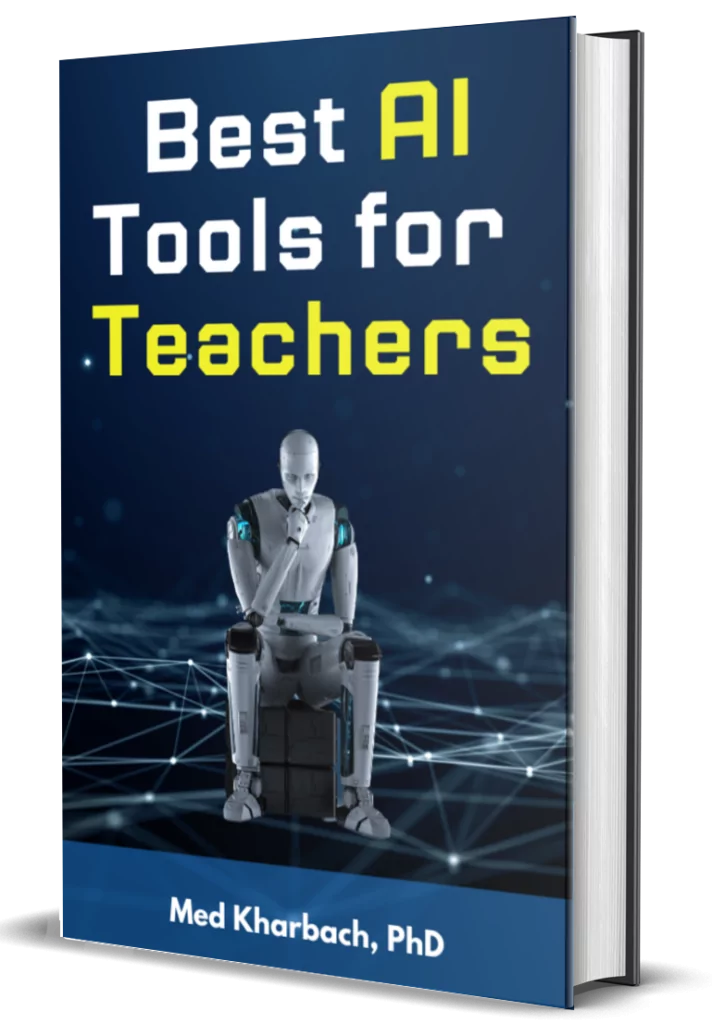.........................
6 of The Best AI Content Detectors for Teachers and Educators
By Med Kharbach, PhD | Last Update: May 26, 2023
AI generated content is now everywhere online. The infamous ChatGPT is but the tip of the iceberg. In fact, AI content generation tools have been around for several months before the introduction of ChatGPT.
Like any other technology, when abused or used inappropriately, these AI tools can turn into a devastating technology, harming content creators and promoting a culture of plagiarism, inauthenticity, and amateurism.
If you are an educator or a teacher, you probably are already dealing with the repercussions of these AI tools in your daily work. More and more students are using AI (especially AI writing tools) to help them with their learning and we can not stop them from doing that. But we can not accept that they turn in AI-generated essays and assignments.

As much as they help in optimizing and creating transformative learning experiences, AI tools also create challenging problems for us in education, most of which are related to plagiarism and originality.
While there are several creative ways to ensure that students use their brains (and not the chatbots’) to create authentic content, we definitely can not (and we should not) shun away AI technologies altogether.
We need to adapt and learn how to leverage AI’s educational potential to create optimal learning experiences for students in and out of class.
In this regard, using AI technology to help with the detection of AI generated content is one among several examples of how we can leverage the power of these technologies to enhance learning.
In this post, I share with you a collection of some of the best AI content detectors out there. You can use these tools to help you identify whether content (e.g., essays, news articles, blog posts, written assignments, etc) are genuinely human written, text bot generated, or a mixture of both human and text bot.
What is an AI content detector?
An AI content detector is an AI software that draws on the power of artificial intelligence to detect linguistic patterns and predict the likelihood of content being generated by a text bot. Using machine learning algorithms, AI content detectors are trained on a huge repository of online data and text and make their predictions based on these language patterns.
How accurate are AI content detectors?
When it comes to AI content detection, accuracy is key. From my own experience using various AI content detectors and my readings into this area, I can assure you that, at least up to this point, it is next to impossible for any AI content detector to provide 100% accurate results.
Why?
Because linguistic patterns are not static and regardless of how much training and language data you feed into an AI detector, there is always more language data left out.Unlike math or statistics, the generative capacity of language is unlimited and coupled with its immense creative potential it becomes impossible for any machine learning to fully understand the workings of human language 100%.
That being said, instead of asking whether an AI detection tool is fully accurate, we should instead inquire about its degree of accuracy. Almost, all of the AI content detection tools include a caveat in their product description which warns against inaccuracies.
This means that when you use these AI content tools you need to exert a higher degree of caution and always keep in mind that their results are merely predictions which can be easily messed up and overwritten.
With these limitations in mind, it is best to treat AI content detection results as guides towards making more informed decisions regarding the authenticity and originality of written content.

Best AI content detectors for teachers and educators
There are several AI content detectors out there, I have tested a number of these tools and came up with this list. Please note that AI detection technology is still in its infancy and that we expect more sophisticated tools to be released as AI technologies become mainstream.
1. Copyleaks
Copyleaks is an excellent AI content detection and plagiarism checker tool. It makes use of advanced algorithms to detect whether content (e.g., essays, blog posts, news articles, books, posts on social media, etc) has been written by a human or generated by an AI writing tool such as ChatGPT or Jasper.
Copyleaks supports various languages including English, French, Spanish, German, and Portuguese. The way it work is simple: copy the text you want to scan, head over to copyleaks.com and paste it in the box then click check. You will get the results within seconds.
Copyleaks also has a handy Chrome extension that enables you to instantly scan content on webpages to detect whether content is written by human, text bots, or a combination of both. Copyleaks offers over 1000 credits for free to test the tool (each credit covers around 250 words of scanned content).
Once your free credits are used up you will need to upgrade to get more credits. As of writing these lines, Copyleaks subscription costs $8.33/month (billed annually) or $9.99/month (billed monthly).
2. Content at Scale
Content at Scale is another powerful AI content detection tool. It uses advanced natural language processing models to detect AI generated content. Simply type your text or paste it into the text area and hit Check for AI Content.
Within seconds you get a human content score that predicts the possibility of your content being fully human written, partially human written, or fully AI generated. You can paste whole articles and essays into the detector. Up to 25.000 characters are supported at a time. Content at Scale is free.
3. Crossplag
Crossplag is another good AI content detection tool. It too uses a combination of machine learning algorithms together with language processing techniques to detect AI writing. To start using Crossplag, you need to create an account.
Next, paste your text in the text box, and Crossplag detector provides a rating score. The higher the score the more likely the content to be AI generated.

4. AI Writing Check
AI Writing Check is developed by Quill.org and CommonLit.org to help teachers check for AI writing in students assignments. Its developers provide an estimate of 80-90% accuracy of the tool.
You can check texts consisting of up to 400 words and for longer texts you need to add them into different sections. AI Writing Check is free to use. There is also an accompanying toolkit created by Quill and CommonLit on AI plagiarism which you can use with students in class.
5. The AI Text Classifier
AI Text Classifier is an AI content detector created by OpenAI for detecting AI writing. Here is what its developers said about the tool ‘s accuracy: “Classifier isn’t always accurate; it can mislabel both AI-generated and human-written text.
“They furner warned that “the Classifier is likely to get things wrong on text written by children and on text not in English, because it was primarily trained on English content written by adults.” Text Classifier is free of charge but you need to log in using your own OpenAI account to use it.
6. GPTZero
GPTZero is an AI content detector that claims to be built for educators. I tested it and found it way better than AI text Classifier.You can either type in or paste your text (minimu 250 characters) or you can upload files (formats supported are PDF, docx, txt) to scan for AI content.
You can even upload multiple files at once which is ideal for use for the entire classroom. While GOTZero is free, it does require you to register to use it.

Join our mailing list
Never miss an EdTech beat! Subscribe now for exclusive insights and resources.
SUBMIT
Meet Med Kharbach, PhD
Dr. Med Kharbach is an influential voice in the global educational technology landscape, with an extensive background in educational studies and a decade-long experience as a K-12 teacher. Holding a Ph.D. from Mount Saint Vincent University in Halifax, Canada, he brings a unique perspective to the educational world by integrating his profound academic knowledge with his hands-on teaching experience. Dr. Kharbach's academic pursuits encompass curriculum studies, discourse analysis, language learning/teaching, language and identity, emerging literacies, educational technology, and research methodologies. His work has been presented at numerous national and international conferences and published in various esteemed academic journals.
Sem comentários:
Enviar um comentário